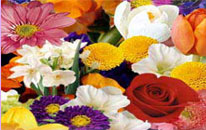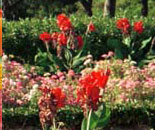In the north of India in Himachal Pradesh, small scale farmers are growing marigold and other flower crops for garlands and decoration. They are relatively easy to cultivate and don't require expensive packaging or processing and so are helping to bring small-scale farmers out of economic distress.
Marigold plants are propagated by planting seeds or cuttings in rows in prepared fields. The developing crops usually require regular watering. Flowers are harvested by hand when about 2 to 3 have developed on each plant. Subsequent harvests can be made at intervals of 3 to 5 weeks. Mechanical harvesters are also sometimes used but these generally limit the number of harvests to one because they can damage the plants.
The farmers of Churah Vale in Chamba district are engaged in growing flowers for the past four to five years. At present, flower cultivation is being done by 81 farmers of the valley on about 6 hectares of land. The flower growers' association of the valley is facing serious problems in marketing their produce and are not getting good prices in the market.
This association with the help of the National Horticulture Board, Delhi, is constructing a cold store and going to procure refrigerated vans very shortly for supplying fresh flowers to the Delhi market.
Last month the Krishi Vigyan Kendra (KVK) Chamba, organised for the first time a two-day training camp on floriculture for flower growers of Churah valley.
Dr Sita Ram, a floriculture expert from Dr Y. S. Parmar University of Horticulture and Forestry, Nauni (Solan), along with KVK scientists imparted training to the growers on improved cultural practices on various flowers such as gladiolus, tulip and lillium.
The expert advised farmers to make necessary alterations in sowing periods according to demand. Farmers were also given scientific tips regarding post-harvest handling, grading and packaging of cut flowers for getting better prices in the market.
Dr Sita Ram highlighted the possibility of growing chrysanthemum in the area. Chrysanthemum is one among the top most cut-flowers of the world which can be a boon to the farmers of the district.
Dr Sita Ram also encouraged farmers to maintain the tempo of flower cultivation. Various varieties of chrysanthemum have been recommended by the University of Horticulture and Forestry, Solan and KVK, Chamba, is going to test these varieties on its own farm to know their suitability for this area.
|


